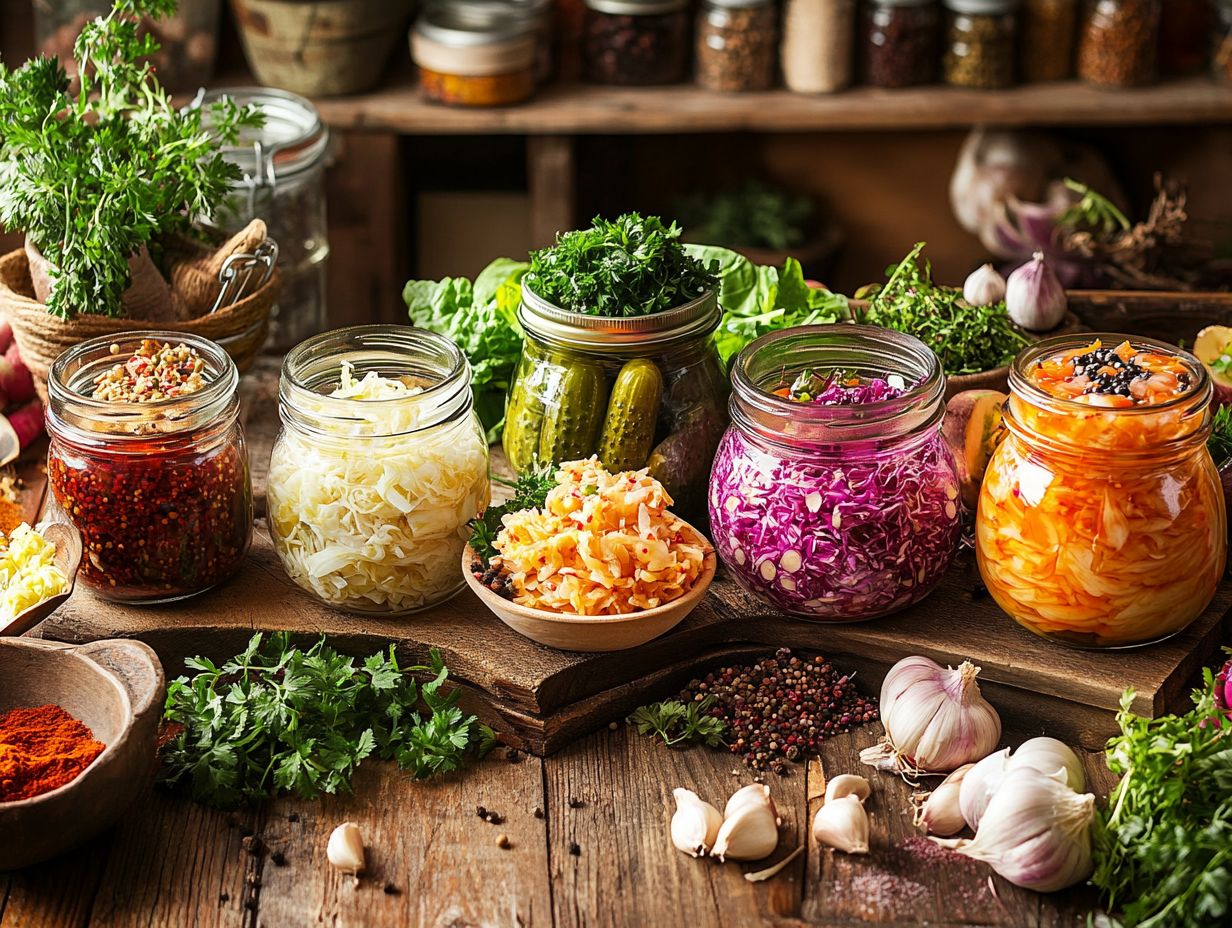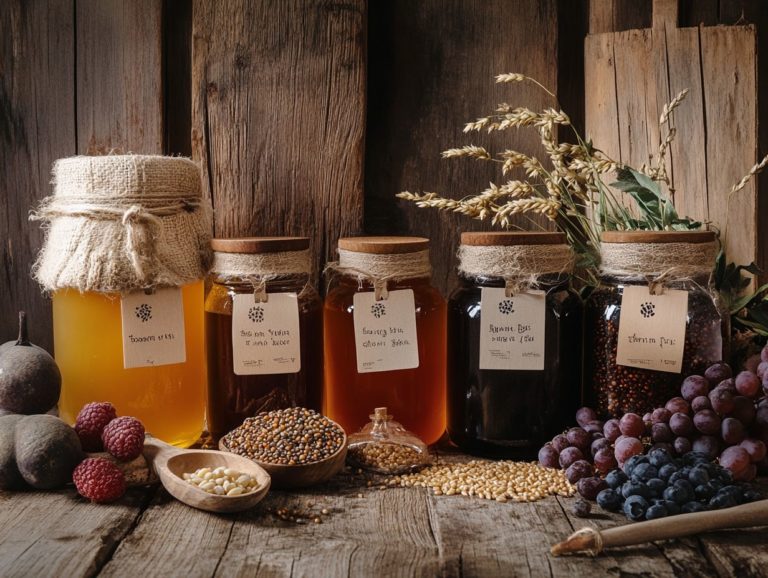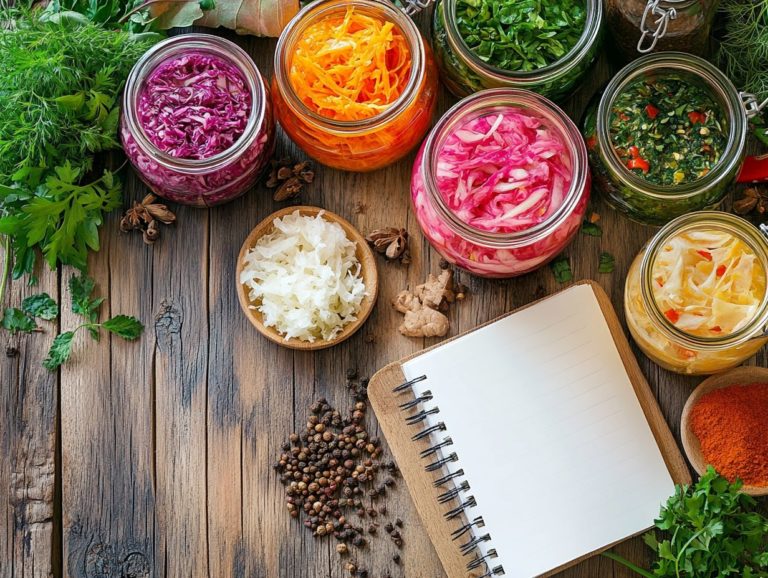How to Use Fermentation to Enhance Flavor
Fermentation transcends the realm of mere food preservation; it is a culinary art that elevates flavors and enhances nutritional value. This age-old practice harnesses the power of microbes to transform food in remarkable ways.
This exploration delves into the captivating world of fermentation, unveiling its myriad benefits in the kitchen and showcasing how it transforms ordinary ingredients into extraordinary culinary delights.
From the science of breaking down complex molecules to the vibrant flavors that emerge in fermented foods, you will uncover practical methods to incorporate these delicious, probiotic-rich foods into your diet, utilizing diverse fermentation techniques and culinary tools.
Get ready to unlock incredible flavors in your meals!
Contents
- Key Takeaways:
- What Is Fermentation?
- Why Is Fermentation Used In Cooking?
- How Does Fermentation Enhance Flavor?
- What Foods Can Be Fermented?
- How to Incorporate Fermented Foods into Your Diet
- Frequently Asked Questions
- What is fermentation and how can it enhance flavor?
- What are some foods that can benefit from fermentation to enhance flavor?
- How does fermentation affect the flavor of food?
- What are the steps to fermenting food to enhance flavor?
- Can fermentation be used to preserve food while enhancing flavor and nutritional value?
- What safety precautions should be taken when fermenting food?
Key Takeaways:
Here are the essential points to remember about fermentation:
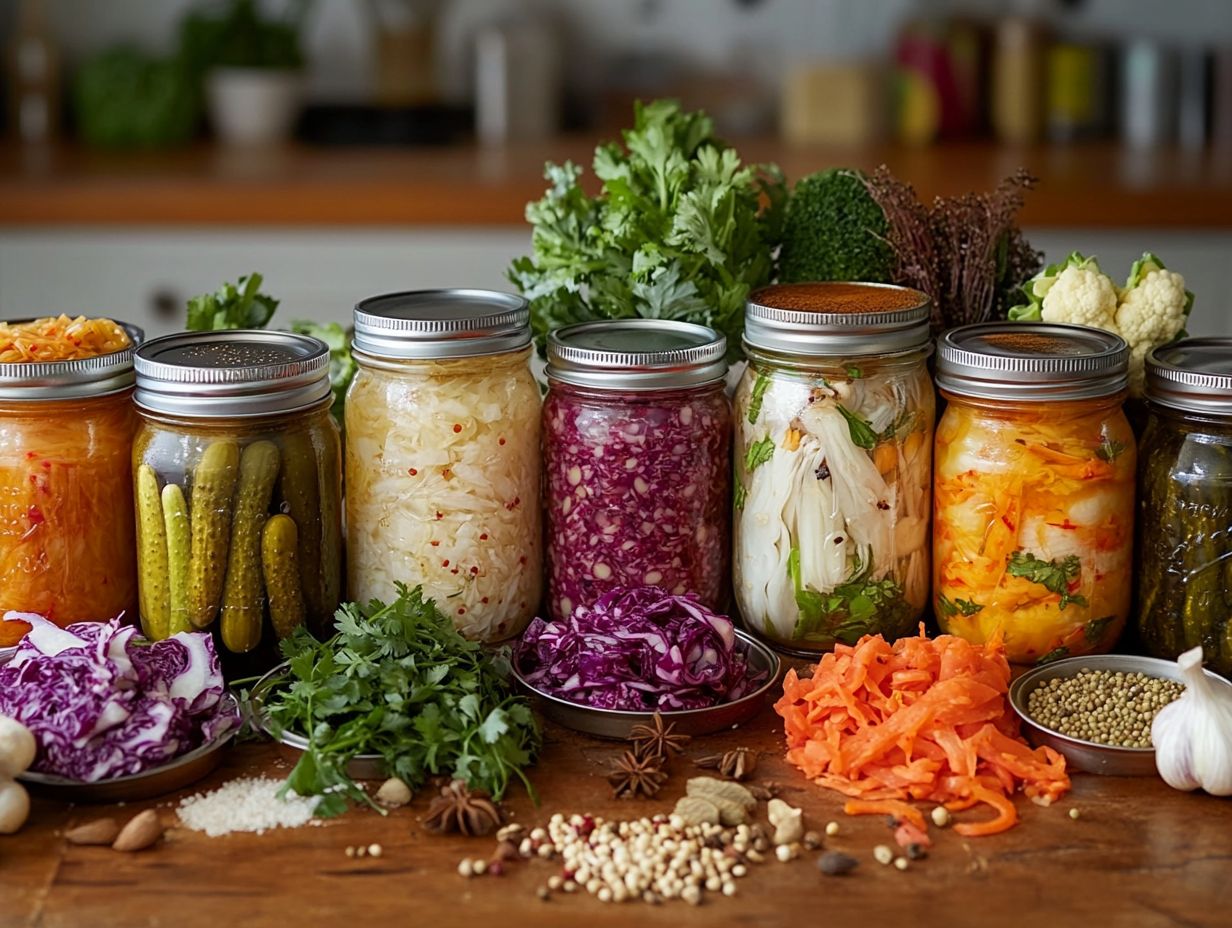
- Fermentation is a process that breaks down complex molecules in food, creating unique and delicious flavors.
- Using fermentation in cooking not only enhances taste but also increases nutrient content and promotes good gut health through the introduction of beneficial bacteria that help with digestion.
- Incorporating fermented foods into your diet is easy and can be done through pickling, making yogurt, or trying different fermented sauces and condiments.
What Is Fermentation?
Fermentation is a remarkable natural metabolic process that transforms sugars into acids, gases or alcohol, all thanks to the work of microorganisms like bacteria, yeast, and molds. This ancient technique has been embraced by cultures around the globe for thousands of years, resulting in a diverse array of fermented foods such as yogurt, kombucha, and kimchi. Fermentation history is rich and varies significantly across different regions and cultures.
These culinary delights not only elevate flavor profiles but also boost nutritional value. The science underpinning fermentation involves intricate chemical reactions that produce distinctive aroma compounds and flavors, making it an essential element in both cooking skills and food preservation.
Why Is Fermentation Used In Cooking?
Fermentation is an esteemed technique in the culinary world, renowned for its extraordinary capacity to amplify flavor, preserve ingredients, and deliver a host of health benefits, especially through the introduction of probiotics.
As you explore the art of cooking, you’ll discover how chefs and food artisans employ diverse fermentation methods such as anaerobic fermentation and aerobic fermentation to craft distinctive dishes that not only embody the essence of their ingredients but also optimize their nutritional potential.
By integrating fermented foods like sauerkraut, yogurt, and sourdough into your culinary repertoire, you ll elevate your flavor profiles. You will also tap into the remarkable benefits of beneficial microbes, promoting gut health and enriching your overall dining experience. The benefits of probiotics, including improved digestion and immune function, are well-documented.
Benefits of Fermentation in Food
The benefits of fermentation in food are truly remarkable, offering you a wealth of advantages. From improving gut health thanks to the presence of probiotics to enhancing nutritional value, fermented foods become more digestible and abundant in vitamins and essential nutrients.
Fermentation cultures, including lactic acid bacteria, play a crucial role in transforming raw ingredients into delightful creations like kimchi, yogurt, and kefir, all of which positively contribute to your overall well-being. These processes significantly reduce food waste by naturally preserving perishable products and extending their shelf life.
But it’s not just about enhancing flavor and digestibility. Fermented foods provide a robust source of gut-friendly probiotics, essential for maintaining a balanced microbiome. This improvement in gut health is vital, as a healthy microbiome is linked to better immune function, digestion, and even mental well-being.
The fermentation process also boosts the bioavailability of nutrients like B vitamins and minerals, making them easier for your body to absorb. By incorporating these foods into your diet, you can enjoy a dual advantage nourishing your body more effectively while also supporting sustainable food practices that minimize food waste.
Consider experimenting with fermentation in your cooking to unlock vibrant flavors and health benefits!
How Does Fermentation Enhance Flavor?
Fermentation is an art that enriches flavor through a series of intricate biochemical transformations. These processes break down complex molecules and give rise to unique aroma compounds, resulting in flavor profiles that are often more nuanced and layered than their unfermented counterparts.
By employing various fermentation techniques, such as anaerobic and aerobic fermentation methods, you can achieve a range of flavor transformations that elevate your culinary creations. Imagine the tangy notes of sourdough or the effervescent qualities of kombucha each a testament to the magic of fermentation.
Beyond enhancing taste, this remarkable process also improves the digestibility of food and extends its shelf life, making it a true ally in both flavor and nourishment.
1. Breaks Down Complex Molecules
During fermentation, you witness a remarkable transformation as complex molecules like carbohydrates and proteins break down into simpler compounds. This intricate process leads to the emergence of new flavor compounds and lactic acid, which imparts that delightful tang to many fermented foods, including popular items like cheese, beer, and wine.
At the heart of this biochemical marvel are reactions facilitated by enzymes, where specific enzymes help to break down larger molecules, yielding sugars and amino acids. As fermentation unfolds, yeast and beneficial bacteria take center stage, further reducing these simpler components through their metabolic pathways.
For instance, when sugars are converted into ethanol and carbon dioxide, this act not only preserves the food but also introduces a rich tapestry of flavors, ranging from fruity esters to spicy phenols. The production of organic acids enhances the overall mouthfeel and complexity of flavors, highlighting the captivating interplay of chemical reactions that underpin the art of fermentation.
2. Creates Unique Flavors

Fermentation is celebrated for its ability to create unique flavors that other cooking methods simply cannot replicate. This magic stems from the diverse array of aroma compounds produced by fermentation cultures throughout the process.
These cultures can vary significantly from one fermented food to another, playing a crucial role in developing distinct flavors that define each product. For example, the tangy, spicy depth you experience in kimchi is largely due to the specific mix of lactic acid bacteria and seasonings, resulting in a vibrant palette of tastes.
In a similar vein, the creamy, tart notes of yogurt come from the interaction of Lactobacillus and Streptococcus bacteria, which enhance its texture and add refreshing acidity. This interplay among various fermentation cultures transforms exploring fermented foods into a delightful journey, unveiling a myriad of flavors and characteristics that narrate their fascinating origins.
3. Increases Nutrient Content
You ll be amazed at how fermentation boosts the nutritional value of foods, resulting in higher concentrations of vitamins and probiotics that support gut health and overall wellness. Fermentation enhances the flavors of your dishes.
This transformation does wonders it not only makes foods more digestible but also enriches them with essential nutrients. Take yogurt, for example; this beloved fermented dairy product is brimming with probiotics that can enhance your digestive health and give your immune system a helpful nudge.
Similarly, sauerkraut, crafted from fermented cabbage, shines with its rich vitamin C content and a plethora of antioxidants that act as a shield against various ailments.
Let s not overlook fermented soy products like miso and tempeh, which serve as excellent plant-based protein sources and may also contribute to heart health by potentially lowering cholesterol levels.
By incorporating fermented foods into your diet, you can significantly enhance your nutritional intake and pave the way for better health outcomes.
What Foods Can Be Fermented?
You can ferment a remarkable array of foods, from crisp vegetables like sauerkraut and kimchi to succulent fruits, creamy dairy products such as yogurt and kefir, and even grains and legumes that give rise to exquisite creations like miso and tempeh. Fermented beverages like kombucha, beer, and wine are also popular choices, showcasing the diversity of fermentation techniques.
Each food type possesses its own unique characteristics, all of which are beautifully brought to life through tailored fermentation techniques. This process creates a variety of flavors and enhances the nutritional profile of the foods you enjoy.
Fermentation goes beyond mere transformation of taste and texture; it plays a vital role in preserving these foods and unlocking their numerous health benefits.
1. Vegetables
Fermented vegetables like sauerkraut and kimchi elevate simple ingredients into complex, flavorful creations. They are brimming with probiotics and nutrients.
The fermentation process improves the taste and aroma of these vegetables, introducing delightful tangy and umami flavors that tantalize the palate. It also represents a significant cultural practice that transcends borders and connects people across various regions of the world. The craftsmanship involved in this tradition speaks volumes about the deep-rooted history and significance of fermented vegetables in different cultures.
For instance, sauerkraut is a staple in German cuisine, reflecting the nation s rich agricultural heritage, while kimchi holds a cherished place in Korean culture, often celebrated for its communal preparation and sharing traditions. Both of these fermented foods showcase the craftsmanship and fermentation history of their respective cultures.
These tasty fermented dishes come packed with health benefits, including improved digestion, boosted immunity, and enhanced nutrient absorption due to the activity of lactic acid bacteria and other beneficial microbes. This makes them not only culinary delights but also essential components of a well-rounded diet.
2. Fruits
Fermented fruits provide a delightful twist to traditional flavor profiles, exemplified by products such as fruit preserves and fermented fruit beverages that elevate both taste and nutritional value through the activity of beneficial microorganisms.
By exploring various fermentation techniques, like lacto-fermentation or wild fermentation, you can transform fresh fruits into tangy, probiotic-rich treats that truly excite your palate. This process, driven by specific fermentation cultures, amplifies the natural sweetness and acidity of the fruits while adding a unique complexity to their taste, making them an excellent complement to your dishes or a satisfying snack on their own.
Consider how kimchi can incorporate fruits like pears, or how kombucha often features tantalizing fruit infusions. Indulging in these fermented delights offers health benefits such as improved digestion and enhanced immunity, showcasing the remarkable value of integrating such innovative products into your diet. These foods demonstrate the potential of fermentation biology to improve overall health.
3. Dairy Products
Dairy products such as yogurt, kefir, and cheese stand as prime examples of fermentation, showcasing the remarkable capabilities of lactic acid bacteria. These fermentation cultures not only create rich flavors and creamy textures but also enhance their nutritional profile and provide significant probiotic benefits.
These microbial processes contribute significantly to the unique tastes and aromas of each product while offering a plethora of health benefits. Take yogurt, for example; it s typically fermented with specific strains like Streptococcus thermophilus and Lactobacillus bulgaricus, which can markedly improve your gut health and digestion through the fermentation process.
Then there’s kefir, which employs a diverse array of bacteria and yeasts, delivering a tangy flavor along with probiotic benefits that bolster immune function.
Cheese production showcases various fermentation techniques, with the aging process further refining unique flavors and concentrating nutrients. The role of fermentation biology in cheese production underscores the importance of fermentation in crafting unique dairy products. Together, these fermented dairy delights offer you not just delicious snacks but also a pathway to better overall health and wellness.
Don t miss out on the chance to enhance your health with these delicious options!
4. Fermented Grains and Legumes
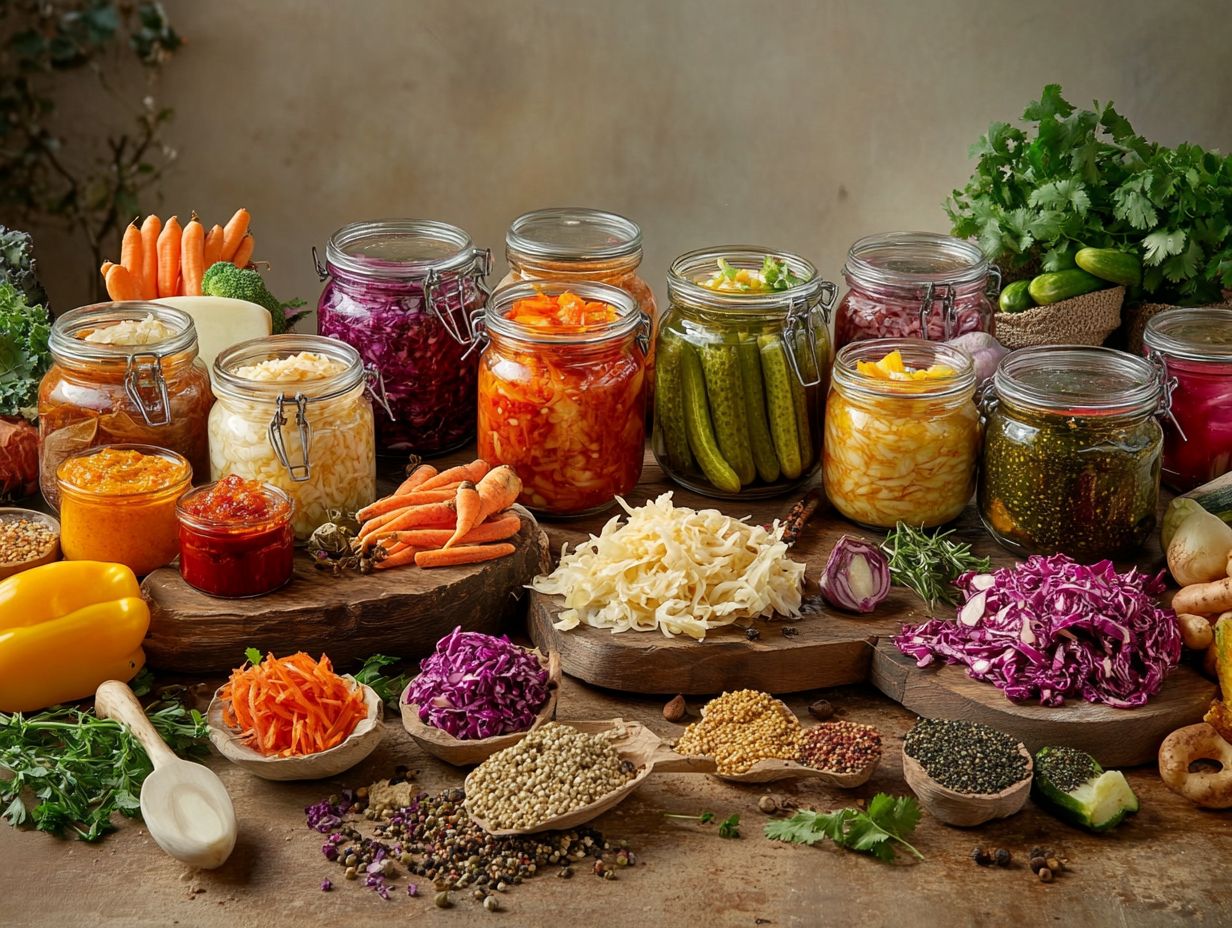
Grains and legumes can undergo fermentation, yielding products like miso and tempeh that not only elevate flavor profiles but also enhance digestibility and amplify nutritional content. This process helps reduce food waste by preserving these foods for longer periods.
These traditional fermentation methods embody rich cultural practices from around the globe, ranging from the soybean-centric dishes of East Asia to the hearty, protein-packed tempeh originating in Indonesia. By employing different fermentation techniques, these methods add beneficial probiotics to foods and break down complex carbohydrates, making essential nutrients more accessible for your body.
Incorporating fermented grains and legumes into your diet can significantly contribute to better gut health, support immune function, and provide a wealth of vitamins and minerals. The chemical reactions during fermentation increase the bioavailability of these nutrients. As you increasingly seek healthier eating options, embracing these fermented staples can offer both culinary enjoyment and a considerable boost to your overall well-being.
How to Incorporate Fermented Foods into Your Diet
Incorporating fermented foods into your diet offers a delightful and enriching experience for your gut health. You can explore a variety of options, such as:
- Pickling vibrant vegetables
- Brewing your own kombucha
- Crafting homemade yogurt
- Enhancing your meals with flavorful fermented sauces and condiments
Each choice not only tantalizes your taste buds but also promotes overall well-being.
1. Try Pickling Vegetables
Pickling vegetables is a delightful and rewarding way for you to introduce fermentation into your culinary repertoire, allowing you to create delicious, fermented vegetables that enhance flavors and preserve freshness. This form of food preservation ensures you can enjoy seasonal produce year-round.
This process can be as uncomplicated as choosing your favorite vegetables think cucumbers, carrots, and radishes and immersing them in a brine solution made from vinegar, water, salt, and spices. These simple tools allow you to engage in anaerobic fermentation, which is crucial for the pickling process.
Essential culinary tools for this endeavor include:
- Jars with airtight lids
- A medium-sized pot for boiling the brine
- A ladle for transferring your mixture
Once the brine cools, you ll submerge the vegetables, sealing in those vibrant flavors while aiding in preservation. But it s not just about taste; pickling comes with a wealth of health benefits as well, such as improved gut health and increased nutrient availability, making these tangy treats both scrumptious and nutritious.
2. Experiment With Kombucha
Brewing kombucha is a delightful and creative adventure that allows you to experiment with fermentation right in your own kitchen, resulting in a fizzy beverage with unique flavor profiles. This fermented beverage showcases the fascinating interplay of yeast and bacteria in fermentation.
This charming drink will excite your taste buds while boosting your gut health, thanks to its impressive probiotic content. To embark on this flavorful journey, gather your essential ingredients: tea, sugar, starter culture, and a SCOBY (symbiotic culture of bacteria and yeast). The chemical reactions during the fermentation of kombucha result in the production of beneficial compounds.
Start by brewing your tea of choice black or green works wonderfully then dissolve sugar into the warm liquid. Once the mixture cools, add the SCOBY and starter tea. Let the magic of fermentation take place over the next week or two, during which you’ll unlock various health benefits, including improved digestion, enhanced immunity, and a boost in energy. The fermentation process in kombucha also leads to the production of small amounts of alcohol.
After the primary fermentation, it’s time to unleash your creativity. Add fruits like ginger, berries, or herbs to craft exquisite flavor combinations. This process rewards you with a delicious beverage while immersing you in the fascinating art of fermentation.
3. Make Your Own Yogurt
Making your own yogurt at home is not just a rewarding experience; it s a healthy venture that puts you in control of every ingredient and the entire fermentation process. Plus, you get to relish the probiotics and flavor benefits of this beloved dairy product, experiencing the full depth of yogurt fermentation.
With just a few essential culinary tools a saucepan, thermometer, whisk, and a container for incubation you can easily embark on this gratifying journey. Start by heating your milk to about 180 F, then let it cool down to around 110 F before introducing a small amount of yogurt as a starter culture. Once you ve mixed it well, pour the mixture into your container and keep it warm for 6 to 12 hours. During this time, the beneficial bacteria will flourish, transforming your milk into thick, creamy yogurt through the process of lactic acid fermentation.
Homemade yogurt isn t just a delicious treat; it s a powerhouse of probiotics that aids digestion and boosts immunity. It also doubles as a versatile ingredient that can enhance your meals. Whether you incorporate yogurt into smoothies, salads, or use it as a substitute for sour cream, you ll elevate flavors while reaping the nutritional benefits making it a delightful addition to your diet. The various flavor changes in homemade yogurt are a testament to the complex fermentation biology involved.
4. Use Fermented Sauces and Condiments
Incorporating fermented sauces and condiments like kimchi and miso into your dishes can elevate flavor profiles while also providing valuable health benefits through probiotics. The chemical compound interactions during fermentation contribute to their rich, complex flavors.
These delightful additions not only introduce a rich depth of umami and complexity to your meals but also support gut health and digestion. For instance, soy sauce and tamari infuse a savory essence into your stir-fries and marinades, while fermented chili sauces can add a spicy kick and unique flavor notes. The fermentation industry continues to innovate, bringing new and exciting flavors to these condiments.
You can begin by drizzling a touch of tahini over roasted vegetables or using post-ferment apple cider vinegar to enliven your salads. By experimenting with these staples and understanding the chemical reactions involved, you open the door to exciting culinary innovations and healthier eating habits, making it effortless to incorporate these nutritious ingredients into your routine.
Frequently Asked Questions
What is fermentation and how can it enhance flavor?
Fermentation is a natural process in which microorganisms, such as bacteria and yeast, convert carbohydrates into acids, gases, or alcohol. This process can enhance the flavor of foods by creating new and complex flavor compounds and aroma compounds.
What are some foods that can benefit from fermentation to enhance flavor?
Foods such as yogurt, cheese, bread, beer, wine, kimchi, and sauerkraut can all benefit from fermentation to enhance their flavor.
How does fermentation affect the flavor of food?
Fermentation can affect the flavor of food in several ways. It can create new and complex flavors, add tanginess or sourness, and increase the umami or savory taste in food. The involvement of different microorganisms in fermentation leads to a variety of flavor development pathways.
What are the steps to fermenting food to enhance flavor?
The steps to fermenting food involve selecting your ingredients, preparing them, and then allowing them to ferment under controlled conditions. Understanding the role of lactic acid, yeast, and other microorganisms can help you achieve better flavor enhancement during fermentation. Specific techniques such as anaerobic fermentation for vegetables or aerobic fermentation for beverages are essential to the process.
The basic steps to fermenting food to enhance flavor and aroma compounds include creating a suitable environment for the desired microorganisms and lactic acid bacteria to grow, adding a starter culture or natural yeast, controlling temperature and time, and allowing the food to ferment until it reaches the desired flavor. This process is essential in producing fermented foods like yogurt, kimchi, and kombucha.
Can fermentation be used to preserve food while enhancing flavor and nutritional value?
Yes, fermentation is an effective method for preserving food. It creates an acidic environment, mainly through lactic acid, which inhibits harmful bacteria and extends shelf life.
For instance, fermented vegetables like sauerkraut and dairy products such as yogurt are popular examples.
What safety precautions should be taken when fermenting food?
Proper sanitation is crucial when fermenting food. Always use clean equipment to prevent contamination.
Monitor the fermentation process closely. This ensures that the food remains safe to consume and does not spoil.
Understanding fermentation techniques and using cultures like probiotics can improve gut health and overall well-being. Those involved in food production should pay special attention to these practices!

